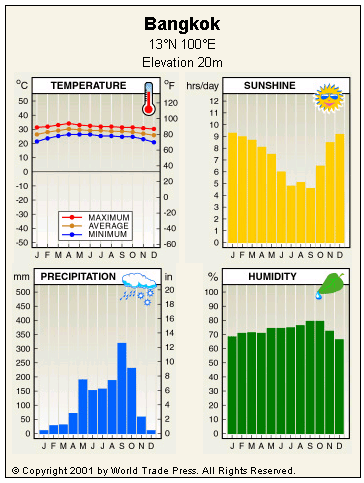Country Snapshot: Climate Overview
Thailand is a Southeast Asian country with an eastern and southern coastline along the Gulf of Thailand, which is an arm of the South China Sea. Most of the country is tropical savanna, with a winter dry season. The southern arm of the country, which extends for roughly 900 kilometers (560 miles), is bound to the west by the Andaman Sea. Its climate is tropical monsoonal, with pronounced wet seasons and a brief dry season.
Seasons
The rainy season extends from May to October, during which abundant rainfall is common. The weather is determined by the southwest monsoon, which blows warm, humid air from the Indian Ocean. The humidity during this period can often feel uncomfortable.
The dry season runs from November to April, with rain falling only a few days per month. During this season, the wind blows from the northeast, mostly traveling overland from China or Indochina. The end of this season represents the hottest time of year for most of the country.
Regional Variations
Thailand has three climatic regions: north, central, and southern. The differences between the regions depend on their relationships to the great Southeast Asian monsoons that drive the climate in this part of the world.
The northern region is hilly and even mountainous, with some lands rising over 2,000 meters (7,000 feet) above sea level. The dry season is much cooler than the wet, with continental winds replacing the hot, humid air of the Indian Ocean; temperatures can be as low as 12°C (54°F) in the dry season, and as high as 35°C (95°F) in the wet season. Monthly rainfall varies from 8‒386 millimeters (0.3‒15 inches), with rainstorms being sudden and torrential.
The central and eastern regions of Thailand are low-lying, with gentle hills and slopes. Temperatures vary little from season to season, ranging from 24‒36°C (75‒97°F). Monthly rainfall is highly variable, ranging from 2‒248 mm (0.1‒9.8 in).
The Kra isthmus, which forms the southern portion of the country, has an equatorial climate. Temperatures remain fairly constant year-round, with ranges between 20‒34°C (68‒93°F). Monthly rainfall can vary from 15‒369 mm (0.6‒15 in), depending on the time of year. The Kra Isthmus represents an exception to the Thai dry season, as the northeast winds draw humid air from the Pacific Ocean or the Gulf of Thailand. The months of February and March receive the least rain for this region.
Copyright © 1993—2025 World Trade Press. All rights reserved.

 Thailand
Thailand 
